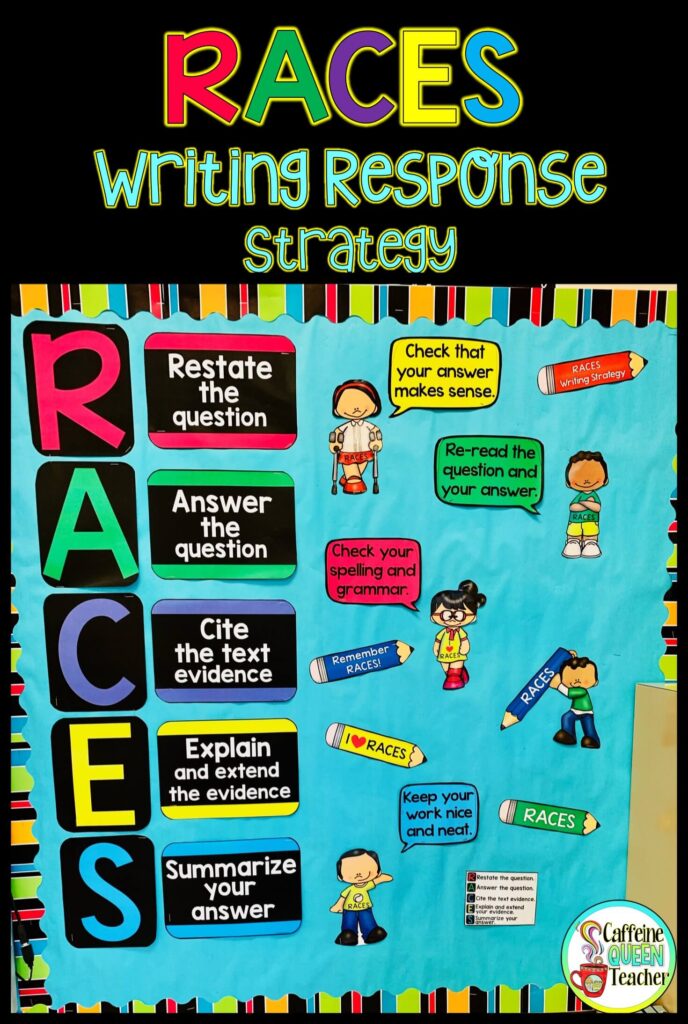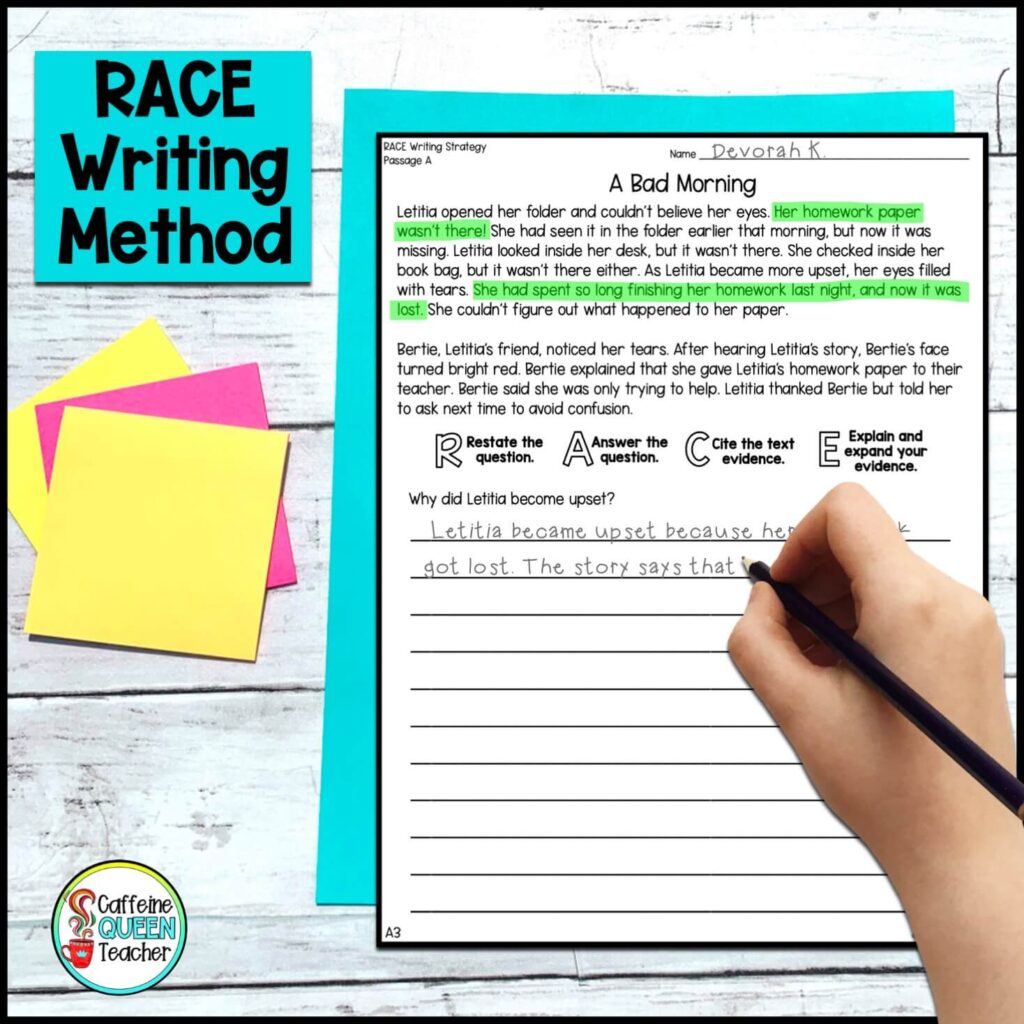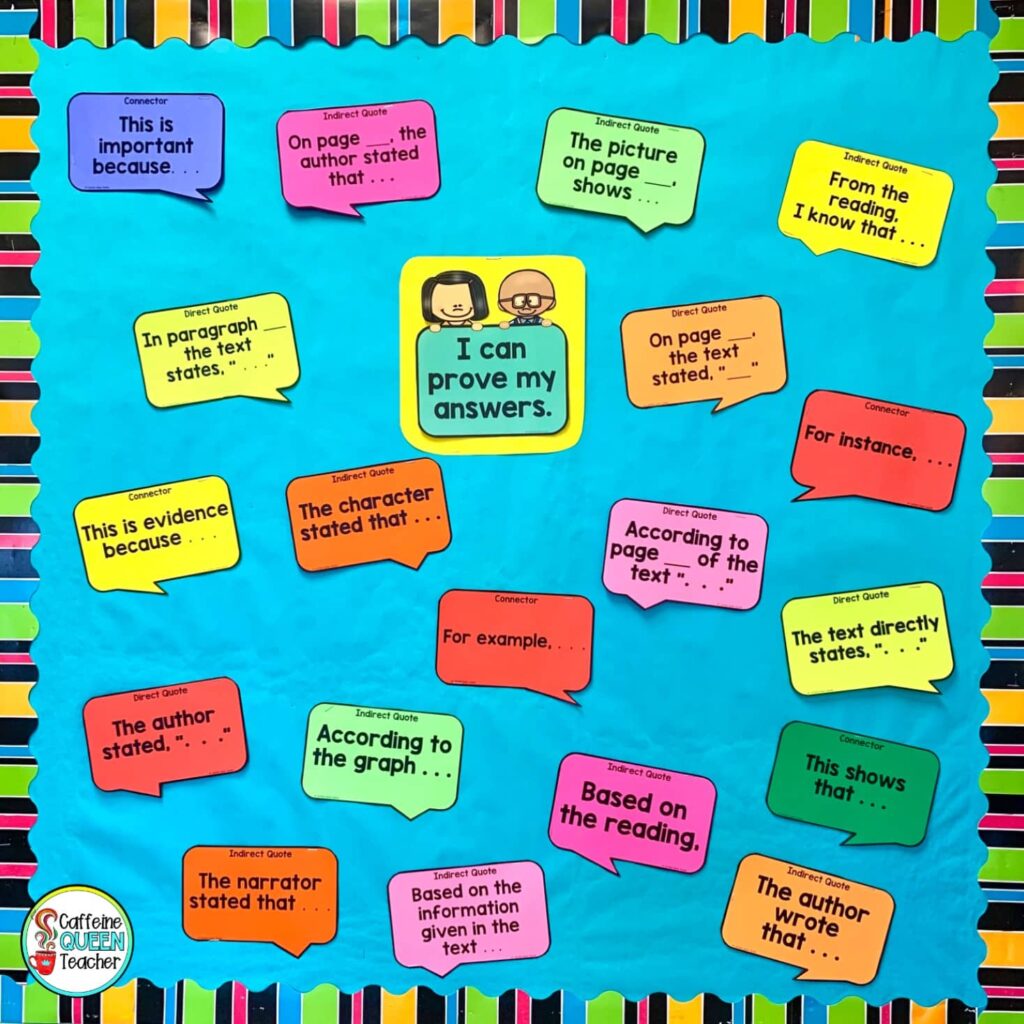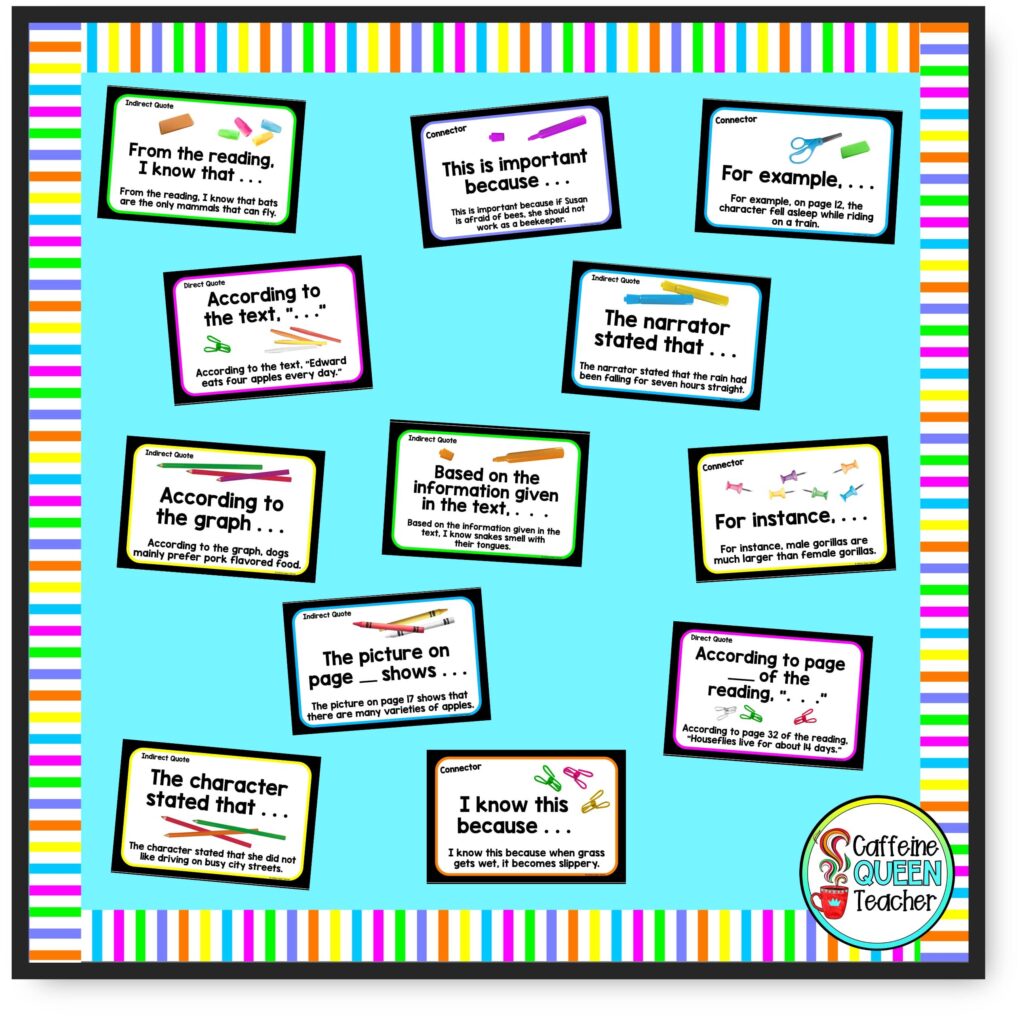Teachers and students rely on the RACE or RACES writing strategies to construct high-quality answers using text evidence.
WHAT IS THE RACE – RACES WRITING RESPONSE STRATEGY?
Students and teachers rely on the RACE – RACES written response strategy for a good reason. It’s a simple method for teaching students how to answer text-based questions.
RACE – RACES helps students remember the key components of a quality response as they answer questions about a passage, story, or text.
Many students aren’t sure how to begin when faced with writing out answers about what they’ve read. This easy-to-use method gives students confidence. Moreover, it’s a concrete strategy they can use in all subject areas.

WHY SHOULD TEACHERS USE RACE/RACES?
Students struggle to write complete answers to text-based questions on tests, quizzes, assignments, and high-stakes tests. RACE/RACES is a step-by-step formula that can be used across all subject areas, leading to increased confidence.
All students benefit from explicit writing instruction. However, reluctant writers require direct instruction on what to write and how to write it. In addition, they should practice regularly to improve their skills.
The RACE/RACES strategy helps students organize their thinking and writing. Students add details, such as citing text evidence and extending their answers, as they follow the steps of the acronym. As a result, students learn essential skills as they practice writing clear and complete responses.
What do the letters in RACE – RACES mean?
First, you need to choose either RACE or RACES for your instruction. RACE/RACES are acronyms that stand for the following writing strategies:
RACE:
R – Restate the question
A – Answer the question
C – Cite the text evidence
E – Explain and extend the evidence
RACES:
R – Restate the question
A – Answer the question
C – Cite the text evidence
E – Explain and extend the evidence
S – Summarize your answer
*Some teachers prefer ACE or ACES. Choose the method that best suits your students and your curriculum.
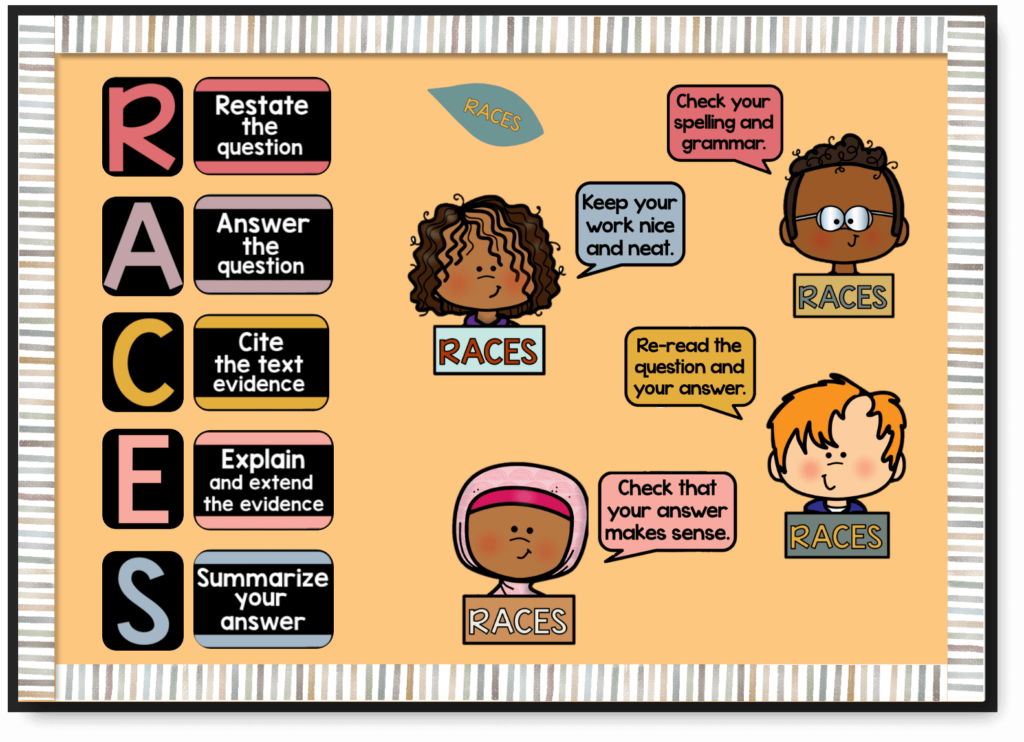
The R in RACE/RACES means “Restate the question.”
Restating the question becomes the topic sentence for the student’s answer. Each letter of RACE/RACES doesn’t have to be a complete sentence on its own. The R is often combined with the A in the same sentence. Remember – writing is individualized, and there’s more than one way of doing it.
The A stands for “Answer the question.”
Students provide the answer to the question in their own words. Unfortunately, many students resist taking the time to refer back to the text. I stress to my students that they need to look back in the reading to find the answer, even if they think they already know it.
Additionally, students need to make sure they answer all parts of the question. Unfortunately, students often answer only part of the question, causing them to lose points.
The C stands for “Cite the text evidence.”
First, students must understand what “cite” means. I often link “cite” to the word “sight” and connect it to looking back at the reading and seeing the answer with their eyes. Building that connection may help some students remember the meaning, especially if “cite” is a new word for them.
I also tell my students this step is where they need to use words and ideas straight from the text. In a follow-up lesson, older students should quote the text using quotation marks, which teachers should directly teach. Younger students can tell what the text says without directly quoting the text.
All students benefit from practicing with sentence starters (also called sentence stems). Sentence starters are the beginnings of sentences that allow students to fill in the blanks with the text evidence. Students (especially struggling students) find them very helpful for this step of the writing process.
Some examples are:
“The text states ___”
“The author explains ___”
There are many good sentence starter choices for students. They should use the ones they’re most comfortable with, and that come most naturally. (If you’re looking for a set you can display in your classroom, see the section at the end for links to matching sentence starter sets!)
The E stands for “Explain and extend the evidence.”
Lots of e’s! This step directs students to expand on their answers. They should explain the answer and text evidence using their own words. They should also provide examples to clarify their explanations.
The S (if you choose to use it) stands for “Summarize your answer.”
Like a summary/closing sentence in paragraph writing, this works as a restatement of the topic sentence. It concludes the response.
How do I teach the RACE/RACES method?
As with any instruction, there are many right ways of teaching a topic. You know your students best, so you can choose and adjust your teaching to their needs. Below are some general guidelines to keep in mind.
1. Choose the right text for the RACE/RACES strategy
Of course, choosing the right text depends entirely on your students. Students can apply the RACE/RACES strategy to any text, so you have many options. But I can offer you the following tips for successful instruction.
Begin with a simple reading comprehension paragraph. It must be simple enough for students to understand yet meaty enough to contain details. We want to keep the focus on answering the question rather than understanding the text. For this purpose, I’ve found it best to begin with a basic passage on an exciting topic.
Eventually, as students practice and improve their skills, you can challenge them with more complex text.
2. Differentiate for students and their needs
Differentiating is pretty easy and straightforward when using RACE/RACES.
During the introduction phase or for struggling students and special education students, choose passages that are familiar in some way to your students. For example, you might select a previously studied topic or a text that students have already read.
3. Use different types of reading materials
We know the importance of exposing our students to a wide variety of reading materials. RACE/RACES can be used for all types of reading. So, as students become accustomed to the RACE/RACES strategy, you can choose any genre or style of reading material and feel confident it will work well.
You may also differentiate by choosing several passages of varying levels for different ability levels in your classroom.
When it’s time to add variety and challenge to the texts, here are some suggestions:
- Vary the text length
- Vary the genre – fiction, nonfiction, persuasion, expository, etc.
- Vary the complexity
- Vary the question types
- Use paired passages
4. Teach important words and terms
- Explain the important terms and methods as you “think aloud.”
- Use the terms frequently each day as you teach. Students learn new words and vocabulary best when they hear it often in a natural way.
5. Use color-coding to highlight
As you’re working through the steps of RACE – RACES, highlight and underline text as you color-code each step using different colors. Then, continue the modeling and think-aloud for as long as students need.
6. Offer visuals for easy reference
Hang visual references in your classroom and encourage students to refer to them. Posters make great visual representations hanging in the classroom. Anchor charts can be developed as a class or in small groups.
Students can use the RACE/RACES bookmarks as references taped to notebooks or desks. Students may benefit from receiving multiple copies of the bookmark references to be kept in notebooks at school and at home.
7. Think about pacing and reviewing
You can teach one step per day, two steps, or more. The pace depends on the age and ability level of your students.
The RACE/RACES strategy must be modeled and practiced many times. The practice should occur as a group, together at first, and then students can be gradually released to independence.
A Quick RACE – RACES Recap:
- Explain important terms and steps as you “think aloud.”
- Model the steps as the class watches.
- Begin encouraging students to contribute their own ideas. Students can read passages and develop answers to text-based questions as a large group, small group, and with partners.
- Transition students to independence after ensuring they understand what’s expected of them.
- Use important terms daily as you teach. Students will gain a deeper understanding as they hear important words used naturally and frequently.
Over time, keep students’ writing skills sharp by continuing to spiral back to practice the RACE – RACES writing technique.
The continued practice may not make students’ writing perfect, but it can help make their skills permanent and keep it fresh in their minds.
Looking for SENTENCE STARTERS?
If you need some Sentence Starters ready to be printed and hung in your classroom, check out the Sentence Starters sets at my Teachers Pay Teachers store. There are two different styles for you to look over.
These sentence starters are also known as writing stems, sentence stems, and constructed response starters.
Want to learn more about citing text evidence?
Your students can successfully cite text evidence when responding to reading comprehension questions.
Step-by-step on how to teach your students to cite text evidence in their reading.
How to Teach Compare and Contrast Essays.
Help students write high-quality responses and prepare for tests with Sentence Starters.
If you use a PLOT DIAGRAM, this article shows you How to Use the Plot Diagram for Teaching.






